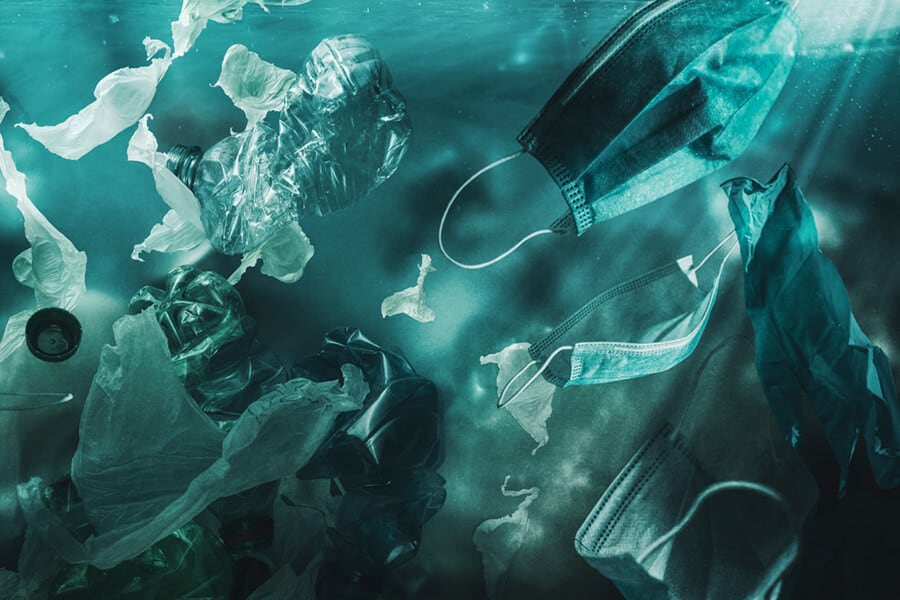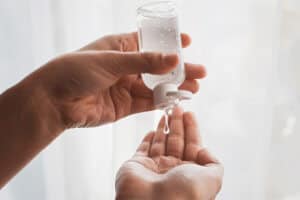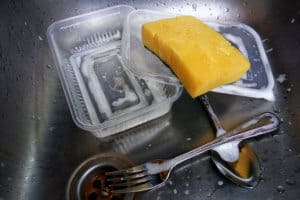With almost 8 billion people living on Earth, our negative impact on the planet is becoming more and more evident. Lately, things have been improving with raised awareness and global efforts to reduce single-use plastics. However, with COVID-19, many zero-waste practices have become a health risk and have been completely overturned. Despite the bleak situation and the flood of facemasks, gloves and other plastics flooding the landfills, there is always hope. There are always ways to do better, waste less and protect our planet.
Hand Sanitizer
The little plastic hand sanitizer bottles have always been a concern for environmentalists. Today, they are being used more than ever before. It is tough to carry larger bottles with you but the little ones don’t last a long time and many people have several to keep in their purses, cars, office, etc. Not only are they wasteful because they are a single-use plastic, but they also dry out your skin which makes people carry around more plastic containers with hand cream, etc.
Unfortunately, it isn’t safe for you or others to just stop using hand sanitizer. It also isn’t a good idea to make your own at home instead of using certified products. The best solution to keep using hand sanitizer in a greener way is to buy a set of small bottles, to have in all the places you need and then a really large one to refill the smaller bottles. Many schools, business and eco-conscious families have been buying these large containers to be able to refill the smaller convenient bottles over and over again. The same can be done with hand creams – although these can be made at home to be even less wasteful.
Not all plastics can be recycled and bottles of hand sanitizer should be cleaned out prior to recycling. Before throwing them away, consider different ways that these could be reused. If you travel, you could use these to store other products such as shampoos and sanitizers to save space in your luggage. They are also great for various crafting projects. Since they are so small, you have to get creative, but you can get some fun ideas for shampoo bottle crafts here.
Face Masks
Wearing face masks is mandatory in businesses and public spaces all over the world. While single-use masks are useful and sometimes necessary, it is best to have reusable masks. Single-use masks are wasteful because they can only be worn once and then get thrown away. Even if they are made from materials that can decompose, if they end up tightly packed in a landfill, they will not be able to break apart naturally.
Not only are single-use face masks wasteful, they are also a hazard to animals. In just a few months during which face masks have become a regular household item, stray masks have been polluting the environment. If you cannot avoid using a single-use face mask, make sure to cut the straps before you dispose of it in the trash. This helps protect animals from getting tangled in them if the mask ends up in the ocean or in nature. Remember that even if you place something in a trash can, it may end up somewhere unexpected and cause irreparable damage.
Reusable face masks are the best option because they can be washed and worn indefinitely. These can be purchased online, in various stores and even made at home. Not only are they reusable but they are more comfortable, customizable and easier to adjust. Once you no longer need the reusable mask, you can dispose of it with other textiles for a minimal environmental footprint.
Fill Your Own Container
A big win for the environment was when more stores started offering package-free stations. Stores such as Whole Foods as well as others have recently been selling nuts, beans and similar foods in a way that allowed customers to bring their own containers and fill them as needed. The concept is that you pay by weight and only get as much or as little as you need. Of course, with the spread of COVID-19 these stations were shut down for safety reasons.
Unfortunately, these stations were one of the only ways to shop for certain products without using plastic. However, this is another case when shopping in bulk is the better option. Every country has stores that sell foods in larger quantities, sometimes meant for resale and restaurants. Consider finding them and buying your favorites in large containers and store smaller amounts in jars for easy access. When shopping for larger amounts, keep expiration dates in mind and make sure to store the food correctly to avoid wasting it.
If you don’t have the money to purchase large quantities of food, or the space to store it, consider teaming up with family, friends or neighbors. Try getting a group of people together and buying large containers of food to share. This will save everyone money and space and will be great for the environment. It is always a good idea to work together as a community when working towards a greener cause.
Buffet Style Eating
Another eco-friendly practice that took a big hit due to the pandemic was buffet style eating where people can serve themselves. Workplaces, restaurants and hotels are now opting for more plastic to keep everyone’s food safe from germs. There isn’t always a way to avoid using plastic when eating out. Obviously, preparing your food at home is the best solution. It takes time and effort but it is the cheapest, greenest and healthiest way to live. Unfortunately, it is not always possible.
Since bringing your own container is no longer possible due to safety-issues, consider keeping your to-go container to reuse at home. Even if you just want to recycle it, it is a good idea to bring it home, clean it properly and recycle it in a bin that you know won’t end up in the dump. If you have the space or imagination, consider keeping these containers for various projects around the house. Of course, the easiest is to use them in the kitchen to store food but they are also great for other trinkets.
The biggest problem with plastic waste is that plastic isn’t meant to be used just once. It is an amazing, durable material that should be put to work. There are many ideas for kids to turn these containers into fun toys such as banjos, totes and even cars. They are also great for the garden and can be spruced up to create beautiful decorations as well as practical storage around the house. If you yourself aren’t crafty, consider asking a local school if they would have use for your extra containers in their classrooms.
Wrap-Up
Before COVID-19 it was tough but possible to avoid any unnecessary plastics in our daily lives. With the influx of face masks and hand sanitizer as well as the loss of refill stations and the ability to bring your own container, the environment is already suffering. The main thing to remember when pursuing a greener lifestyle is not to have an all-or-nothing mindset. Just because we can’t avoid plastic doesn’t mean we can’t use less. As long as everyone strives to do a little better, we can make an impact. If all seven billion people reuse just one bottle of hand sanitizer, that’s seven billion less bottles in the landfill!
Photos: Shutterstock
Here are some interesting ways of reusing plastic that could also impact your community!
Precious Plastic: A Global Community of Recycling Entrepreneurs
Project Syahi: Reducing Plastic Waste and Challenging the Patriarchy
Support us!
All your donations will be used to pay the magazine’s journalists and to support the ongoing costs of maintaining the site.
Share this post
Interested in co-operating with us?
We are open to co-operation from writers and businesses alike. You can reach us on our email at [email protected]/[email protected] and we will get back to you as quick as we can.













